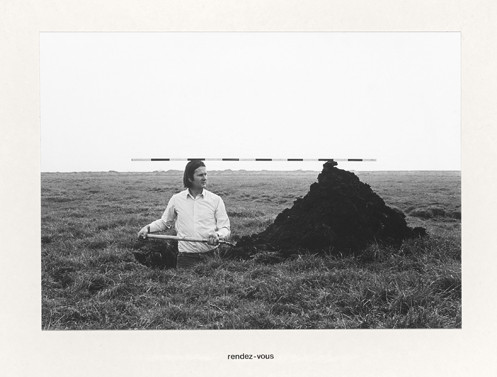Sigurdur Gudmundsson
24 Sep - 06 Nov 2011

© Sigurdur Gudmundsson, Rendez-vous, 1976
Sigurdur Gudmundsson
Rendez-vous , 1976. Foto: Moderna Museet/Juan Luis Sánchez. Courtesy: i8 Gallery, Reykjavik & Galleri Bo Bjerggaard, Copenhagen
Sigurdur Gudmundsson
Rendez-vous , 1976. Foto: Moderna Museet/Juan Luis Sánchez. Courtesy: i8 Gallery, Reykjavik & Galleri Bo Bjerggaard, Copenhagen
In the course of his career, the Icelandic artist Sigurdur Gudmundsson has expressed himself in most media – photography, text, sculpture, painting, performance. The exhibition at Moderna Museet Malmö focuses on his early photographic works, called “Situations”, from the 1970s and 1980s.
"For travel in time and space, art is a highly suitable vessel. The first road into a new world often goes via a work of art. "
Sigurdur Gudmundsson, 1969
In the first half of the 1960s, Sigurdur Gudmundsson saw nature as an omniscient authority. Nature was a mirror of the soul, reflecting the pure and the good. The search for truth lay therein, and by extension, the encounter with art. This experience of beauty/truth was not lasting, however. The tension between the viewer and the work fades with time, leaving a sense of emptiness. In search of the next experience we move on – in time and space – with the aim of finally becoming the truth ourselves.
The spiritual and immaterial values expressed in Sigurdur Gudmundsson’ philosophy were prevalent also in the roughly contemporary Fluxus movement. Irony in combination with these serious ideas attracted Sigurdur Gudmundsson, just as the artist Joseph Beuys had influenced him profoundly in the mid-1960s. Gudmundsson’s early works also contain references to René Magritte, Joseph Kosuth and Caspar David Friedrich.
A series of photos shows the spectator Sigurdur Gudmundsson in an absurd situation. These “Situations”, the collective name for this series, have the format of a poem, to be read by the viewer. Gudmundsson has said that his art has largely centred on exploring what is unknown to him. Perhaps this can explain his digging in sand next to a stack of books in Structures (1977), his search for balance in Composition (Study) (1978) and Dialogue (1979), or his looking under a paving stone in Event (1975). The “Situations” are not rarely about finding the way. And despite being occasionally comical, the images convey a distinct gravity when shown together as they are here. Absurdity and occasional comedy shift into a mood of melancholy and a flight from life on earth as we know it.
Curators: Magnus Jensner and Andreas Nilsson
"For travel in time and space, art is a highly suitable vessel. The first road into a new world often goes via a work of art. "
Sigurdur Gudmundsson, 1969
In the first half of the 1960s, Sigurdur Gudmundsson saw nature as an omniscient authority. Nature was a mirror of the soul, reflecting the pure and the good. The search for truth lay therein, and by extension, the encounter with art. This experience of beauty/truth was not lasting, however. The tension between the viewer and the work fades with time, leaving a sense of emptiness. In search of the next experience we move on – in time and space – with the aim of finally becoming the truth ourselves.
The spiritual and immaterial values expressed in Sigurdur Gudmundsson’ philosophy were prevalent also in the roughly contemporary Fluxus movement. Irony in combination with these serious ideas attracted Sigurdur Gudmundsson, just as the artist Joseph Beuys had influenced him profoundly in the mid-1960s. Gudmundsson’s early works also contain references to René Magritte, Joseph Kosuth and Caspar David Friedrich.
A series of photos shows the spectator Sigurdur Gudmundsson in an absurd situation. These “Situations”, the collective name for this series, have the format of a poem, to be read by the viewer. Gudmundsson has said that his art has largely centred on exploring what is unknown to him. Perhaps this can explain his digging in sand next to a stack of books in Structures (1977), his search for balance in Composition (Study) (1978) and Dialogue (1979), or his looking under a paving stone in Event (1975). The “Situations” are not rarely about finding the way. And despite being occasionally comical, the images convey a distinct gravity when shown together as they are here. Absurdity and occasional comedy shift into a mood of melancholy and a flight from life on earth as we know it.
Curators: Magnus Jensner and Andreas Nilsson
